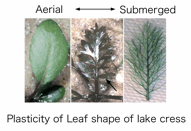Associate Professor Seisuke Kimura
 ■Area and Subject Taught:Plant Developmental Biology
■Area and Subject Taught:Plant Developmental Biology
■Research Theme(s):Analysis of phenotypic plasticity of leaf shape
■Academic Degrees:Ph. D.
■Keywords for Research Field:Plant, Development, Leaf, Plasticity
[Research Overview]
 Plant can alter their development, physiology and life history depending on environmental conditions. This fundamental property is called phenotypic plasticity. The North American lake cress, Neobeckia aquatica is an herbaceous perennial aquatic mustard. Typical habitat of lake cress is at shores of ponds, slow-moving streams and other quiet waters in North America. The lake cress shows heterophylly, phenotypic plasticity on leaf shape. In nature, the leaf shape of this plant depends on whether the plant is submerged in or emergent from water. Submerged leaves are usually deeply dissected and has needle-like blade, whereas emergent leaves are generally entire with serrated or smooth margins. This phenotypic plasticity on leaf shape is thought to be adaptive response to submergence and increase the fitness in water's edge environment where most of lake cress populations are found. Despite the significance of this plant to study fundamental mechanisms of phenotypic plasticity and environmental responses in plants, the underlying mechanism hasn't been investigated. We investigate the mechanism of the heterophylly of Neobeckia aquatica.
Plant can alter their development, physiology and life history depending on environmental conditions. This fundamental property is called phenotypic plasticity. The North American lake cress, Neobeckia aquatica is an herbaceous perennial aquatic mustard. Typical habitat of lake cress is at shores of ponds, slow-moving streams and other quiet waters in North America. The lake cress shows heterophylly, phenotypic plasticity on leaf shape. In nature, the leaf shape of this plant depends on whether the plant is submerged in or emergent from water. Submerged leaves are usually deeply dissected and has needle-like blade, whereas emergent leaves are generally entire with serrated or smooth margins. This phenotypic plasticity on leaf shape is thought to be adaptive response to submergence and increase the fitness in water's edge environment where most of lake cress populations are found. Despite the significance of this plant to study fundamental mechanisms of phenotypic plasticity and environmental responses in plants, the underlying mechanism hasn't been investigated. We investigate the mechanism of the heterophylly of Neobeckia aquatica.
[Notable Publications and Works]
- Uchida, N., Kimura, S., Koenig, D., and Sinha, N. (2010). Coordination of leaf development via regulation of KNOX1 genes. J Plant Res 123, 7-14.
- Kimura, S., and Sinha, N. (2009). Tomato (Solanum lycopersicum): A Model Fruit-bearing Crop. In Emerging Model Organisms: a Laboratory Manual, Volume 1. (New York: Cold Spring Harbor Laboratory Press).
- Kimura, S., Koenig, D., Kang, J., Yoong, F.Y., and Sinha, N. (2008). Natural Variation in Leaf Morphology Results from Mutation of a Novel KNOX Gene. Curr Biol 18, 672-677.